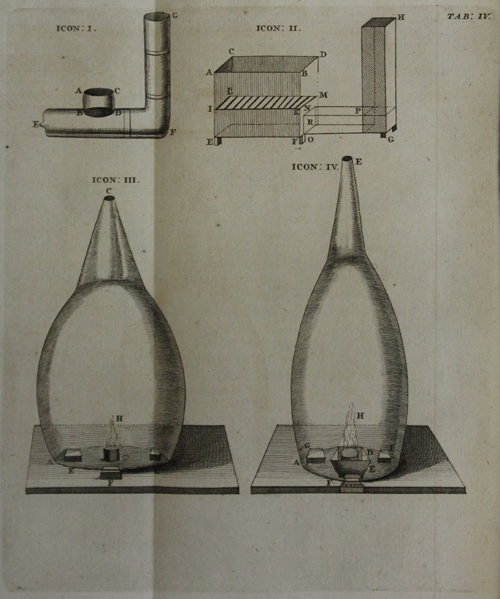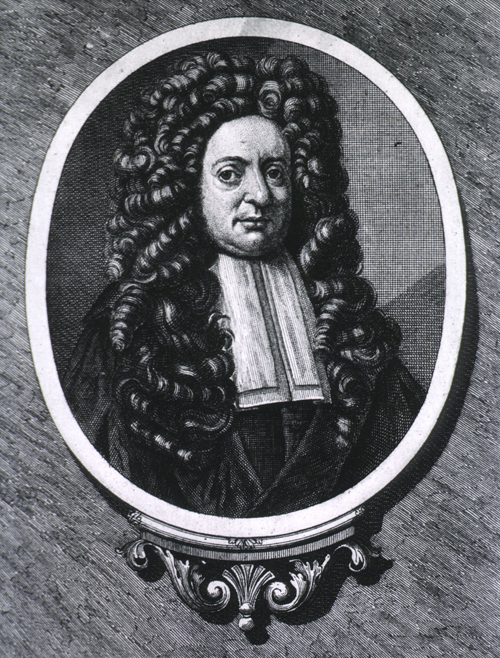Leiden
Teaching Chemistry at Leiden
The University of Leiden, founded in 1575, played a leading role in the development of chemical teaching in early modern Europe. Teachers such as Franciscus Sylvius de le Boë (1614-72) and Worth’s contemporary, Herman Boerhaave (1668-1738), spread the fame of Leiden as a centre of chemical research. Sylvius de le Boë had been responsible for setting up the university’s first chemical laboratory and his iatro-chemical school of medical philosophy, a philosophy which explained medicinal cures in terms of chemical reactions, was immensely influential in the later seventeenth century. Boerhaave likewise sought to develop the role of chemistry, though this time in a different direction. As Powers says (2006), ‘Boerhaave made chemistry (and his whole medical system) philosophically dependent on physics’.
Courtesy of the National Library of Medicine.
Worth collected a 1695 Utrecht edition of Sylvius’ Opera Medica and Boerhaave’s two-volume Leiden 1732 edition of Elementa chemiae and undoubtedly was intrigued by his contemporary’s approach to chemistry. It is, however, important to realise that his official teacher was neither of these men. For Worth came to Leiden in the 1690s, when the Professor of Chemistry was Jacob Le Mort (1650-1718), a lecturer more interested in the preparation of chemical recipes than in advancing chemical theory. In this Le Mort was following in the footsteps of his predecessors and colleagues: Carel de Maets (1640-90) and Christaan Marggraf (1626-87). Before his appointment to the Chair of Chemistry, Carel de Maets had been taught by Rudolf Glauber at Amsterdam and following that had been a privatdozent (private teacher) of chemistry at Utrecht. The lure of the chemical laboratory at Leiden was too much for him and he chose Leiden.
De Maets’ chemical lectures at Leiden were included in Christopher Love Morley’s Collectanea chymica Leydensia (Leiden, 1684), a compilatory volume of lectures by de Maets, Marggraf and Le Mort which, unsurprisingly, is in Worth’s collection. It provides us with an invaluable insight into chemical teaching at Leiden between Sylvius and Boerhaave. Morley had studied at Leiden, graduating M.D. in 1679, and his book proved to be relatively popular, being translated into German (Jena, 1696) and published in a second Latin edition at Antwerp in 1702. As Van Spronsen (1975) suggests, it is difficult to identify what belongs to De Maets (the official lecturer in chemistry until his death in 1690), and to his colleagues (and, indeed, all three objected to its publication). Le Mort, like De Maets, had been taught by Glauber at Amsterdam. He had initially helped De Maets in the Leiden laboratory before starting his own laboratory – an action which did not win him friends in the university. De Maets in particular was opposed to his erstwhile colleague but on the latter’s death it was Le Mort who inherited the university laboratory, though not De Maets’ academic position. In fact, Le Mort was allowed to lecture by the university but he was not made Professor of Chemistry until 1702.
Le Mort’s bête noire was Christiaan Marggraf who had previously studied medicine at Leiden, taking his doctorate in 1659. Marggraf set up an un-official chemistry course, one to which Le Mort strenuously objected and the two engaged in a bitter printed debate. From Marggraf’s and Le Mort’s printed works we can see that the latter was highly influenced by the corpuscularian concept of matter and borrowed a great deal from Boyle as well as Descartes. Le Mort’s chemistry focused on earth, water, salt and mercury.
Le Mort remained as Professor of Chemistry at the University of Leiden until his death in 1718 and the chair at that point was added to Boerhaave’s many other dignities. It is known that Le Mort became progressively less interested in teaching in later years and that the young up-and-coming Boerhaave had already lured away students while teaching as a privaat docent prior to his university appointments. Did he teach Worth? It was only in 1701, the year when Worth graduated M.D. at Utrecht, that Boerhaave was officially let into the academic fold, being appointed lecturer, so he did not do so in an official capacity. However, Boerhaave had set up a private practice in Leiden after 1693, the year in which he took his degree at Harderwijk, so it is possible that he either taught him privately or, given the relative size of the city, knew him socially.
Courtesy of the National Library of Medicine.
In 1701 Boerhaave was appointed to the academic staff of Leiden, to lecture on the Institutiones medicae and in the following year he began teaching a chemistry course. By 1709 he had become Professor of Botany and Medicine and in 1718, on the death of Le Mort, he was appointed Professor of Chemistry. Powers (2006) shows us how Boerhaave sought to redefine chemistry within the University of Leiden. Following on from the ‘artisan’ approach of De Maets, Marggraf and Le Mort, which had concentrated on the creation of medicinal compounds, Boerhaave advocated not only a practical but also a theoretical approach. In the words of Powers, Boerhaave ‘created a new field, didactic philosophical chemistry’. Part of this was based on the Leipzig professor Johann Bohn’s Dissertationes Chymico-Physicae (1685) which had provided the reader with a set of dissertations based on ‘chemical’ subjects. Boerhaave’s lecture course may have expanded the subjects under discussion but its structure closely followed that of Bohn.
Boerhaave may have held both the Chair of Medicine and the Chair of Chemistry simultaneously but this did not mean that he sympathized with iatrochemistry of either Paracelsus or Van Helmont. From his academic oration of 1703 onwards he made it clear that for him, physics was paramount and, as Debus (1992) states, he considered himself a mechanist. In his view the iatrochemists’ positioning of medicine as somehow subservient to chemistry was ill conceived. For Boerhaave, chemistry was important but not because it provided an overarching philosophical framework for medicine. Instead, he determined to develop chemistry as a distinct subject in its own right.

Herman Boerhaave, Elementa chemiae (Leiden, 1732), Table IV.
Boerhaave’s Elementa Chemiae was one of the most influential textbooks on chemistry in the eighteenth century – not only in Leiden but also, because of Leiden’s dominance in medical teaching, throughout Europe. Lindeboom (1974) explores Boerhaave’s impact on British chemical teaching and rightly states that Boerhaave was ‘the greatest and most successful teacher of chemistry of the early eighteenth century.’ The illustration on the main page of this section of the website, which depicts Boerhaave lecturing to a large academic group is a reminder of just how popular his teaching was. Because of his fame as a teacher students flocked to Leiden from Britain and elsewhere and it is therefore unsurprising that when he decided to publish his chemical course it proved to be immensely influential. The first volume concentrated on theory and the second on practice. The concentration on practice in volume two mirrored Boerhaave’s earlier preoccupations at the start of his official career at Leiden for, as Gibbs (1958) reminds us, lectures notes for his 1702 course survive in manuscripts form. It is clear that the Elementa Chemiae of 1732 was written as a response to the proliferation of un-official versions of his course, some in manuscript form, others printed, the unauthorised 1724 Institutiones et Experimenta Chemiae being a case in point. Much of the Elementa Chemiae therefore was written some decades after Worth’s sojourn in Leiden: Gibbs (1958), who provides a useful list of editions, draws our attention to the fact that Boerhaave prepared the book in the year 1728-9, his last year as professor of chemistry. The work was quickly translated into English (the standard translation being Shaw’s 1741 translation); French (1748); German (1733-34) and was also available in abridged formats.
Sources
Boran, Elizabethanne (2010), ‘The sceptical collector: alchemy and chemistry in early modern Irish medical libraries’ in Westerhof, Danielle (ed.) The Alchemy of Medicine and Print. The Edward Worth Library (Dublin), pp 75-88.
Clericuzio, Antonio (2000), Elements, Principles and Corpuscles. A Study of Atomism and Chemisty in the Seventeenth Century (Kluwer Academic Publishers).
Debus, Allen G. (1986), ‘Chemistry and the Universities in the Seventeenth Century’, Academiae Analecta: Klasse der Wetenschappen, 48, 15-33 (30-31).
Debus, Allen G. (1992), ‘Alchemy and Iatrochemistry: Persistent traditions in the 17th and 18th Centuries’, Química Nova 15 (3), 262-268.
Debus, Allen G. (2001), Chemistry and Medical Debate: Van Helmont to Boerhaave (Science History Publications).
Gibbs, F. W. (1958), ‘Boerhaave’s Chemical Writings’, Ambix VI, no. 3, 117-35.
Lindeboom, G. A. (1974), Boerhaave and Great Britain (Leiden).
J. F. Payne, Patrick Wallis (2004), ‘Morley, Christopher Love (b. 1645/6)’, rev. Patrick Wallis, Oxford Dictionary of National Biography (Oxford University Press).
Powers, John C. (2006), ‘Chemistry Enters the University: Herman Boerhaave and the Reform of the Chemical Arts’, History of Universities 21 (2) 77-116.
Van Spronsen, J. W. (1975), ‘The Beginning of Chemistry’, in Lunsingh Scheurleer, Th. H. and Posthumus Meyjes, G. H. M. (ed.) Leiden University in the Seventeenth Century. An Exchange of Learning (Leiden), pp 329-343.



